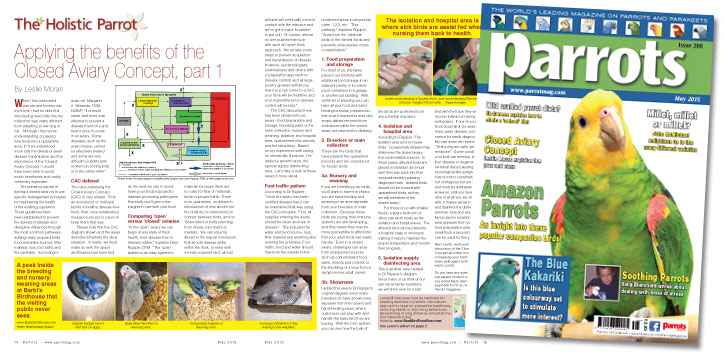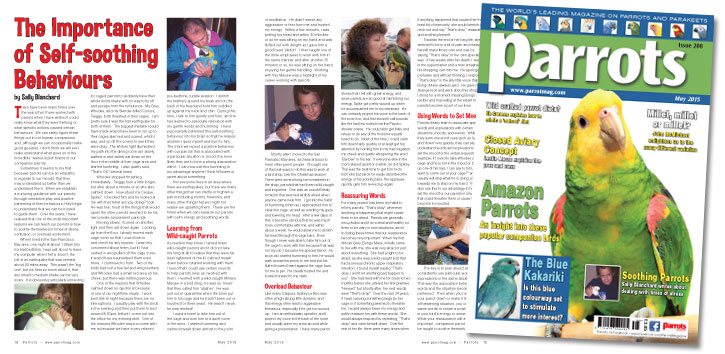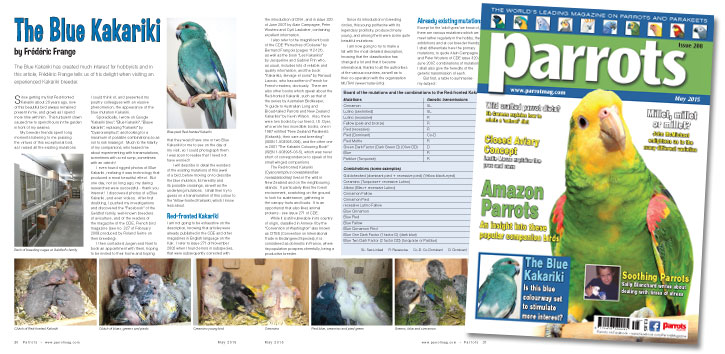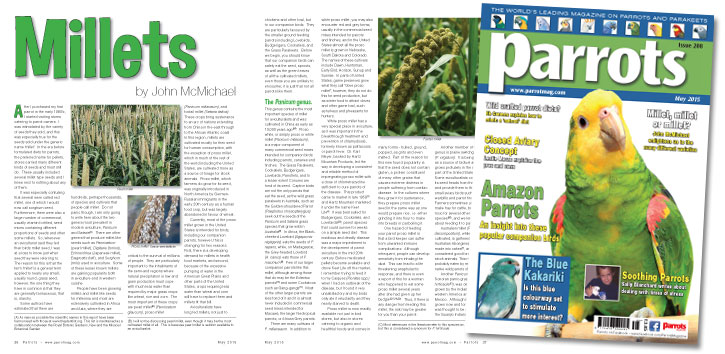
Applying the benefits of the Closed Aviary Concept, part 1
by Leslie Moran
When I first welcomed parrots and finches into my home I had no idea that introducing new birds into my collection was vastly different from adopting a new dog or cat. Although I had some understanding of placing new birds into a quarantine area, if I had understood more fully the details of avian disease transmission and the importance of the 'Closed Aviary Concept', I would have been able to avoid much heartbreak and costly veterinary expenses.
The primary purpose of having a closed aviary is to use specific management principles for maintaining the health of the existing population. These guidelines have been established to prevent the spread of disease and disruptive influences through the most common pathways - adding newly acquired birds, food and water sources, litter material, toys, foot traffic and the caretaker. According to avian vet, Margaret A. Wissman, DVM, DABVP, “It is much easier and more cost effective to prevent a disease than to try and treat it once it occurs in an aviary. Some diseases, such as the avian viruses, cannot be effectively treated and some are very difficult to identify ante mortem (in a living bird) or in the carrier state.”
Buy Now!

by Sally Blanchard
There have been many times over the years that I have worked with parrots when I have wished I could really know what they were thinking or what specific actions caused certain behaviours. We can rarely figure these things out in our human companions and, although we can occasionally make good guesses, I don’t think we will ever really understand what goes on in the incredible ‘walnut-sized’ brains of our companion parrots.
Sometimes it seems to me that because parrots can be so empathic in regards to our moods, that they may understand us better than we understand them. When we establish a nurturing guidance with our parrots through interactive play and positive patterning of their behaviours, they begin to understand that we can be trusted to guide them. Over the years, I have realised that one of the most important lessons we can teach our parrots is how to soothe themselves in times of stress, confusion, or overload excitement.
Buy Now!

by Frédéric Frange
The Blue Kakariki has created much interest for hobbyists and in this article, Frédéric Frange tells us of his delight when visiting an experienced Kakariki breeder.
Since getting my first Red-fronted Kakariki about 20 years ago, love of this beautiful bird always remained present in me, and grows as I spend more time with him. This turbulent clown caused me to spend hours in the garden in front of my aviaries.
My breeder friends spent long moments listening to me praising the virtues of this exceptional bird, as I raised all the existing mutations I could think of, and presented my poultry colleagues with an elusive phenomenon, the appearance of the blue mutation Kakariki.
Buy Now!

by John McMichael
After I purchased my first parrot in the early 1980's, I started visiting stores catering to parrot owners. I was intimidated by the variety of seeds they sold, and this was especially true for the seeds sold under the generic name 'millet'. In the era before formulated diets for parrots, the preferred name for pellets, stores carried many different kinds of seeds and most still do. These usually included several millet type seeds and I knew next to nothing about any of them.
It was especially confusing that several were called red millet, one of which I would now call sorghum seed. Furthermore, there were also a large number of commercial, usually vitamin fortified, seed mixes containing different proportions of seeds and often some millets. So, whenever an aviculturist said they fed their birds millet seed, I was at a loss to know just what seed they were referring to. The reason for this is that the term 'millet' is a general term applied to nearly any small, usually round, grass seed, however, the one thing they have in common is that they are generally farinaceous, that is, starchy.
Buy Now!




